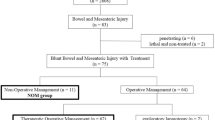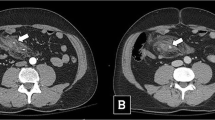Abstract
Background
Early recognition of bowel and mesenteric injury following blunt abdominal trauma remains difficult. We hypothesized that patients with intra-abdominal adhesions from prior laparotomy would be subjected to visceral sheering deceleration forces and increased risk for bowel and mesenteric injury following blunt abdominal trauma.
Methods
We performed a multicenter retrospective cohort analysis of 267 consecutive adult trauma patients who underwent operative exploration following moderate-critical (abdominal injury score 2–5) blunt abdominal trauma, comparing patients with prior laparotomy (n = 31) to patients with no prior laparotomy (n = 236). Multivariable regression was performed to identify predictors of bowel or mesenteric injury.
Results
There were no significant differences between groups for injury severity scores or findings on abdominal ultrasound, diagnostic peritoneal aspirate/lavage, pelvic radiography, or preoperative CT scan. The prior laparotomy cohort had greater incidence of full thickness bowel injury (26 vs. 9%, p = 0.010) and mesenteric injury (61 vs. 31%, p = 0.001). The proportion of bowel and mesenteric injuries occurring at the ligament of Treitz or ileocecal region was greater in the no prior laparotomy group (52 vs. 25%, p = 0.003). Prior laparotomy was an independent predictor of bowel or mesenteric injury (OR 5.1, 95% CI 1.6–16.8) along with prior abdominal inflammation and free fluid without solid organ injury (model AUC: 0.81, 95% CI 0.74–0.88).
Conclusions
Patients with a prior laparotomy are at increased risk for bowel and mesenteric injury following blunt abdominal trauma. The distribution of bowel and mesenteric injuries among patients with no prior laparotomy favors embryologic transition points tethering free intraperitoneal structures to the retroperitoneum.


Similar content being viewed by others
References
Nishijima DK, Simel DL, Wisner DH et al (2012) Does this adult patient have a blunt intra-abdominal injury? JAMA 307(14):1517–1527
Watts DD, Fakhry SM, Group EM-IHVIR (2003) Incidence of hollow viscus injury in blunt trauma: an analysis from 275,557 trauma admissions from the East multi-institutional trial. J Trauma 54(2):289–294
Rizzo MJ, Federle MP, Griffiths BG (1989) Bowel and mesenteric injury following blunt abdominal trauma: evaluation with CT. Radiology 173(1):143–148
Beck D, Marley R, Salvator A et al (2004) Prospective study of the clinical predictors of a positive abdominal computed tomography in blunt trauma patients. J Trauma 57(2):296–300
Udekwu PO, Gurkin B, Oller DW (1996) The use of computed tomography in blunt abdominal injuries. Am Surg 62(1):56–59
Nelson JB, Bresticker MA, Nahrwold DL (1992) Computed tomography in the initial evaluation of patients with blunt trauma. J Trauma 33(5):722–727
Mackersie RC, Tiwary AD, Shackford SR et al (1989) Intra-abdominal injury following blunt trauma. Identifying the high-risk patient using objective risk factors. Arch Surg 124(7):809–813
Grieshop NA, Jacobson LE, Gomez GA et al (1995) Selective use of computed tomography and diagnostic peritoneal lavage in blunt abdominal trauma. J Trauma 38(5):727–731
Richards JR, Derlet RW (1998) Computed tomography for blunt abdominal trauma in the ED: a prospective study. Am J Emerg Med 16(4):338–342
Poletti PA, Mirvis SE, Shanmuganathan K et al (2004) Blunt abdominal trauma patients: can organ injury be excluded without performing computed tomography? J Trauma 57(5):1072–1081
Holmes JF, Wisner DH, McGahan JP et al (2009) Clinical prediction rules for identifying adults at very low risk for intra-abdominal injuries after blunt trauma. Ann Emerg Med 54(4):575–584
Atri M, Hanson JM, Grinblat L et al (2008) Surgically important bowel and/or mesenteric injury in blunt trauma: accuracy of multidetector CT for evaluation. Radiology 249(2):524–533
Park MH, Shin BS, Namgung H (2013) Diagnostic performance of 64-MDCT for blunt small bowel perforation. Clin Imaging 37(5):884–888
Renz BM, Feliciano DV (1995) Unnecessary laparotomies for trauma: a prospective study of morbidity. J Trauma 38(3):350–356
Schnuriger B, Lam L, Inaba K et al (2012) Negative laparotomy in trauma: are we getting better? Am Surg 78(11):1219–1223
Li T, Robertson-More C, Maclean AR et al (2015) Bowel obstructions and incisional hernias following trauma laparotomy and the nonoperative therapy of solid organ injuries: a retrospective population-based analysis. J Trauma Acute Care Surg 79(3):386–392
Fakhry SM, Brownstein M, Watts DD et al (2000) Relatively short diagnostic delays (<8 hours) produce morbidity and mortality in blunt small bowel injury: an analysis of time to operative intervention in 198 patients from a multicenter experience. J Trauma 48(3):408–414 (discussion 414–405)
Landry BA, Patlas MN, Faidi S et al (2016) Are we missing traumatic bowel and mesenteric injuries? Can Assoc Radiol J 67(4):420–425
Fakhry SM, Watts DD, Luchette FA et al (2003) Current diagnostic approaches lack sensitivity in the diagnosis of perforated blunt small bowel injury: analysis from 275,557 trauma admissions from the EAST multi-institutional HVI trial. J Trauma 54(2):295–306
Beal AL, Ahrendt MN, Irwin ED et al (2016) Prediction of blunt traumatic injuries and hospital admission based on history and physical exam. World J Emerg Surg 11(1):46
Jost E, Roberts DJ, Penney T et al (2017) Accuracy of clinical, laboratory, and computed tomography findings for identifying hollow viscus injury in blunt trauma patients with unexplained intraperitoneal free fluid without solid organ injury. Am J Surg 213(5):874–880
Chandler CF, Lane JS, Waxman KS (1997) Seatbelt sign following blunt trauma is associated with increased incidence of abdominal injury. Am Surg 63(10):885–888
Parmley LF, Mattingly TW, Manion WC et al (1958) Nonpenetrating traumatic injury of the aorta. Circulation 17(6):1086–1101
Feczko JD, Lynch L, Pless JE et al (1992) An autopsy case review of 142 nonpenetrating (blunt) injuries of the aorta. J Trauma 33(6):846–849
Burkhart HM, Gomez GA, Jacobson LE et al (2001) Fatal blunt aortic injuries: a review of 242 autopsy cases. J Trauma 50(1):113–115
Moore RG, Partin AW, Adams JB et al (1995) Adhesion formation after transperitoneal nephrectomy: laparoscopic v open approach. J Endourol 9(3):277–280
Jorgensen JO, Lalak NJ, Hunt DR (1995) Is laparoscopy associated with a lower rate of postoperative adhesions than laparotomy? A comparative study in the rabbit. Aust N Z J Surg 65(5):342–344
Mahmood I, Tawfek Z, Abdelrahman Y et al (2014) Significance of computed tomography finding of intra-abdominal free fluid without solid organ injury after blunt abdominal trauma: time for laparotomy on demand. World J Surg 38(6):1411–1415. https://doi.org/10.1007/s00268-013-2427-5
Peduzzi P, Concato J, Kemper E et al (1996) A simulation study of the number of events per variable in logistic regression analysis. J Clin Epidemiol 49(12):1373–1379
Ng AK, Simons RK, Torreggiani WC et al (2002) Intra-abdominal free fluid without solid organ injury in blunt abdominal trauma: an indication for laparotomy. J Trauma 52(6):1134–1140
Brasel KJ, Olson CJ, Stafford RE et al (1998) Incidence and significance of free fluid on abdominal computed tomographic scan in blunt trauma. J Trauma 44(5):889–892
Hulka F, Mullins RJ, Leonardo V et al (1998) Significance of peritoneal fluid as an isolated finding on abdominal computed tomographic scans in pediatric trauma patients. J Trauma 44(6):1069–1072
Livingston DH, Lavery RF, Passannante MR et al (1998) Admission or observation is not necessary after a negative abdominal computed tomographic scan in patients with suspected blunt abdominal trauma: results of a prospective, multi-institutional trial. J Trauma 44(2):273–280 (discussion 280–272)
Hasson HM (1971) A modified instrument and method for laparoscopy. Am J Obstet Gynecol 110(6):886–887
Chi I, Feldblum PJ, Balogh SA (1983) Previous abdominal surgery as a risk factor in interval laparoscopic sterilization. Am J Obstet Gynecol 145(7):841–846
Rafii A, Camatte S, Lelievre L et al (2005) Previous abdominal surgery and closed entry for gynaecological laparoscopy: a prospective study. BJOG 112(1):100–102
Drollette CM, Badawy SZ (1992) Pathophysiology of pelvic adhesions. Modern trends in preventing infertility. J Reprod Med 37(2):107–121 (discussion 121–102)
Gutt CN, Oniu T, Schemmer P et al (2004) Fewer adhesions induced by laparoscopic surgery? Surg Endosc 18(6):898–906
Acknowledgements
This work was supported in part by Grants R01 GM113945-01 (PAE), R01 GM105893-01A1 (AMM), and P50 GM111152–01 (FAM, SCB, PAE, AMM) awarded by the National Institute of General Medical Sciences (NIGMS). TJL was supported by a post-graduate training grant (T32 GM-008721) in burns, trauma and perioperative injury by NIGMS. Research reported in this publication was supported by the National Center for Advancing Translational Sciences of the National Institutes of Health under Award Number UL1TR001427. The content is solely the responsibility of the authors and does not necessarily represent the official views of the National Institutes of Health.
Author information
Authors and Affiliations
Corresponding author
Ethics declarations
Conflict of interest
The Authors declare that they have no conflict of interest.
Electronic supplementary material
Below is the link to the electronic supplementary material.
Rights and permissions
About this article
Cite this article
Loftus, T.J., Morrow, M.L., Lottenberg, L. et al. The Impact of Prior Laparotomy and Intra-abdominal Adhesions on Bowel and Mesenteric Injury Following Blunt Abdominal Trauma. World J Surg 43, 457–465 (2019). https://doi.org/10.1007/s00268-018-4792-6
Published:
Issue Date:
DOI: https://doi.org/10.1007/s00268-018-4792-6




